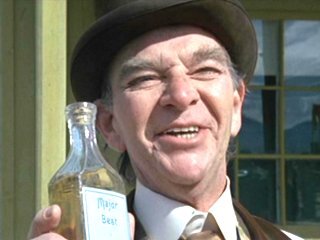Hawkeye Saint
Calmer than you.
Offline
When I was a kid those two were the antiseptic of choice. After my first introduction to Merthiolate, I never complained about mecurochrome ever again. Decided I'd rather live with the cuts and scrapes. A painful, yet effective treatment at the time.
So whatever happened to Mercurochrome and Merthiolate? How do they work?
A. Mercurochrome is a trade name for merbromin, a compound containing mercury and bromine. Merthiolate is a trade name for thimerosal, a compound containing mercury and sodium.
Both these compounds kill some (but not all) disease-causing microbes by denaturing enzymes and other proteins so that the microbes' metabolism is blocked; they do this by breaking up chemical bonds in the proteins.
Both have been widely used as topical antiseptics, applied to the surface of the skin of a living body. Thimerosal is still often used to help rid skin of bacteria before medical procedures. Mercurochrome is not widely used anymore.
Both Mercurochrome and Merthiolate (and iodine preparations, too) sting when applied to broken skin and can interfere with healing. Experts now recommend that first aid kits contain newer antibacterial creams, especially those containing bacitracins, a class of antibacterials first produced by other microorganisms.
Mecuricome is a dark red topical antiseptic containing mercury. Before the proliferation of over the counter first aid medicines, and FDA regulations which stopped its manufacture, Mecuricome was used throughout the world to treat minor cuts, scrapes, sores, and other external infectious conditions. The liquid was only sold in small quantities, since one application by Q-tip was extremely effective.
So whatever happened to Mercurochrome and Merthiolate? How do they work?
A. Mercurochrome is a trade name for merbromin, a compound containing mercury and bromine. Merthiolate is a trade name for thimerosal, a compound containing mercury and sodium.
Both these compounds kill some (but not all) disease-causing microbes by denaturing enzymes and other proteins so that the microbes' metabolism is blocked; they do this by breaking up chemical bonds in the proteins.
Both have been widely used as topical antiseptics, applied to the surface of the skin of a living body. Thimerosal is still often used to help rid skin of bacteria before medical procedures. Mercurochrome is not widely used anymore.
Both Mercurochrome and Merthiolate (and iodine preparations, too) sting when applied to broken skin and can interfere with healing. Experts now recommend that first aid kits contain newer antibacterial creams, especially those containing bacitracins, a class of antibacterials first produced by other microorganisms.
Mecuricome is a dark red topical antiseptic containing mercury. Before the proliferation of over the counter first aid medicines, and FDA regulations which stopped its manufacture, Mecuricome was used throughout the world to treat minor cuts, scrapes, sores, and other external infectious conditions. The liquid was only sold in small quantities, since one application by Q-tip was extremely effective.


